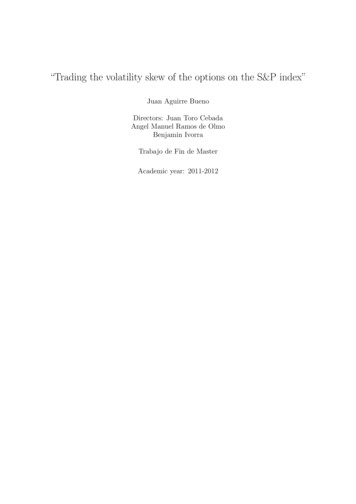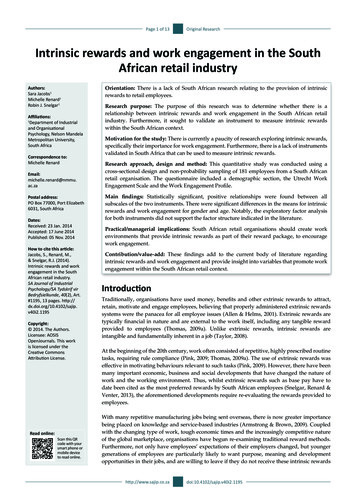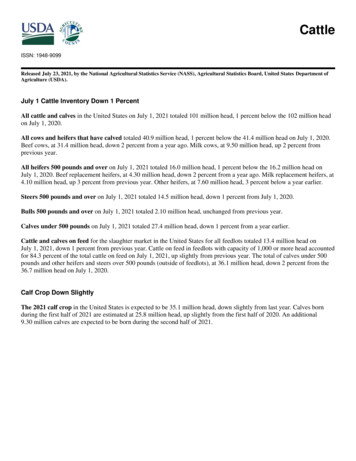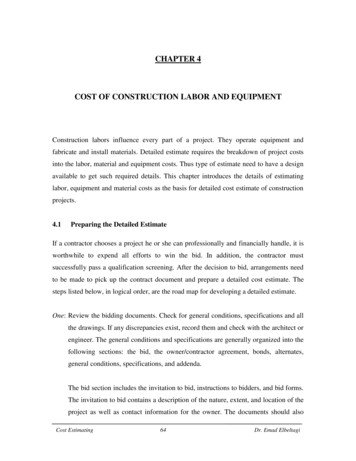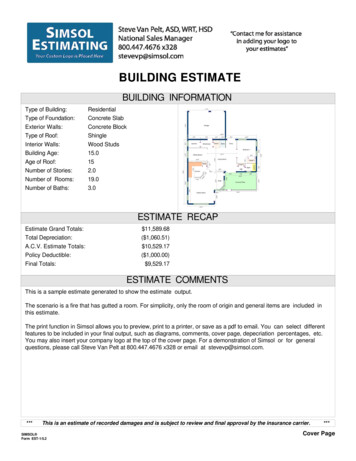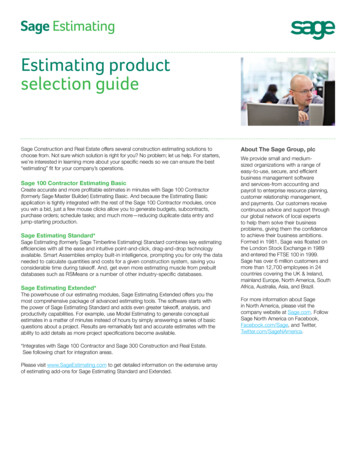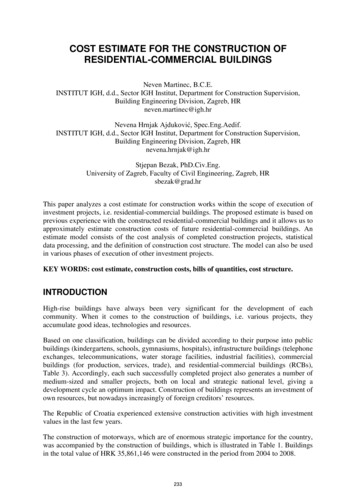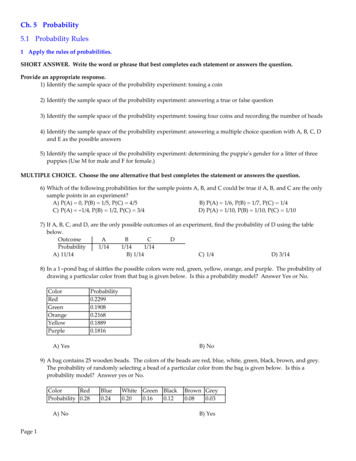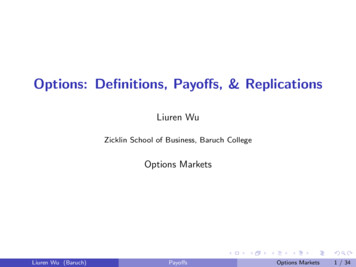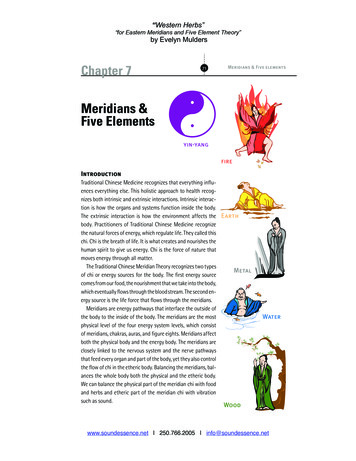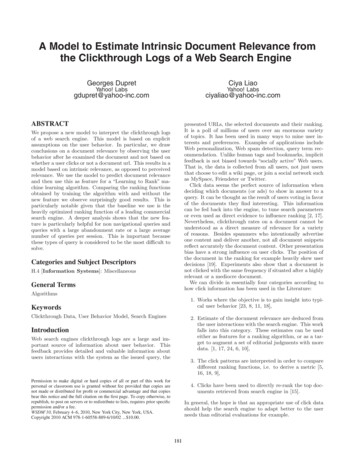
Transcription
A Model to Estimate Intrinsic Document Relevance fromthe Clickthrough Logs of a Web Search EngineGeorges DupretCiya LiaoYahoo! LabsYahoo! TRACTpresented URLs, the selected documents and their ranking.It is a poll of millions of users over an enormous varietyof topics. It has been used in many ways to mine user interests and preferences. Examples of applications includeWeb personalization, Web spam detection, query term recommendation. Unlike human tags and bookmarks, implicitfeedback is not biased towards “socially active” Web users.That is, the data is collected from all users, not just usersthat choose to edit a wiki page, or join a social network suchas MySpace, Friendster or Twitter.Click data seems the perfect source of information whendeciding which documents (or ads) to show in answer to aquery. It can be thought as the result of users voting in favorof the documents they find interesting. This informationcan be fed back into the engine, to tune search parametersor even used as direct evidence to influence ranking [2, 17].Nevertheless, clickthrough rates on a document cannot beunderstood as a direct measure of relevance for a varietyof reasons. Besides spammers who intentionally advertiseone content and deliver another, not all document snippetsreflect accurately the document content. Other presentationbias have a strong influence on user clicks. The position ofthe document in the ranking for example heavily skew userdecisions [19]. Experiments also show that a document isnot clicked with the same frequency if situated after a highlyrelevant or a mediocre document.We can divide in essentially four categories according tohow click information has been used in the Literature:We propose a new model to interpret the clickthrough logsof a web search engine. This model is based on explicitassumptions on the user behavior. In particular, we drawconclusions on a document relevance by observing the userbehavior after he examined the document and not based onwhether a user clicks or not a document url. This results in amodel based on intrinsic relevance, as opposed to perceivedrelevance. We use the model to predict document relevanceand then use this as feature for a “Learning to Rank” machine learning algorithm. Comparing the ranking functionsobtained by training the algorithm with and without thenew feature we observe surprisingly good results. This isparticularly notable given that the baseline we use is theheavily optimized ranking function of a leading commercialsearch engine. A deeper analysis shows that the new feature is particularly helpful for non navigational queries andqueries with a large abandonment rate or a large averagenumber of queries per session. This is important becausethese types of query is considered to be the most difficult tosolve.Categories and Subject DescriptorsH.4 [Information Systems]: MiscellaneousGeneral TermsAlgorithms1. Works where the objective is to gain insight into typical user behavior [23, 8, 11, 18],KeywordsClickthrough Data, User Behavior Model, Search Engines2. Estimate of the document relevance are deduced fromthe user interactions with the search engine. This workfalls into this category. These estimates can be usedeither as features for a ranking algorithm, or as a target to augment a set of editorial judgments with moredata. [1, 17, 24, 6, 10],IntroductionWeb search engines clickthrough logs are a large and important source of information about user behavior. Thisfeedback provides detailed and valuable information aboutusers interactions with the system as the issued query, the3. The click patterns are interpreted in order to comparedifferent ranking functions, i.e. to derive a metric [5,16, 18, 9],Permission to make digital or hard copies of all or part of this work forpersonal or classroom use is granted without fee provided that copies arenot made or distributed for profit or commercial advantage and that copiesbear this notice and the full citation on the first page. To copy otherwise, torepublish, to post on servers or to redistribute to lists, requires prior specificpermission and/or a fee.WSDM’10, February 4–6, 2010, New York City, New York, USA.Copyright 2010 ACM 978-1-60558-889-6/10/02 . 10.00.4. Clicks have been used to directly re-rank the top documents retrieved from search engine in [15].In general, the hope is that an appropriate use of click datashould help the search engine to adapt better to the userneeds than editorial evaluations for example.181
Contributions and Organization.1.1 AssumptionsWe propose a model of user behavior based on the useractions after he has consulted a document, i.e. after he hasclicked an url and examined the corresponding document1 .The objective of the model is to derive an estimate of document intrinsic relevance, as opposed to perceived relevanceor attractiveness. In Section 1 we describe the model. InSection 2 we compare the hypothesis and the performanceof this model to two existing and related models. In Section 3.2 we evaluate experimentally the usefulness of themodel estimates as a feature for a ranking algorithm. Weconclude that the feature is particularly helpful for querieswith a large abandonment rate or the informational querieswith a large average number of click per session.The central assumption in this model is that the usersearches the result list of the original query and its reformulations until he has gathered enough information to satisfyhis need, independently of how far the relevant documentsare in the ranking or how hard it is to come up with a goodreformulation. All sessions ending with a click are therefore considered as successful. There is no notion of a userabandoning a search out of despair in this model. We arenot arguing that this assumption is verified in reality –it isnot– but numerical experiments will show that the resultingmodel is nevertheless useful.Each clicked document dr provides some utility ur tothe user. We make the hypothesis that utilities are additive: The utility of thePprototypical session at the endof the search is U (C) r C ur u3 u5 u13 whereC {d3 , d5 , d13 } is the set of clicked documents. The assumption that utilities can be simply added is clearly anapproximation. More realistically the total utility of a setof documents is lower than the sum of individual documentutilities because some documents might partially or fully repeat the same information.After the user clicked on document d3 of our example, sheacquired a quantity u3 of utility. The fact that she continuesher search after consulting the document indicates that shedid not obtain enough utility to satisfy her information need.After consulting document u5 , she acquired an amount u3 u5 of utility, but still not enough for her to stop. Only afterconsulting u3 u5 u13 does she have enough informationand she stops the search. The different steps of this searchare summarized in the first three columns of Table 1.Sometimes a user clicks several time on the same document. If the time between two clicks is small, and if no otherdocument has been clicked in between, then this might denote either that the user is used to double-clicking, or thatthe network latency is large. In this case, repeated clickscan be treated as a single click. On the other hand, if thetime lapse between two clicks on the same url is large orthe user clicked other documents in between, this might bethat the user came to the conclusion that the document hevisited multiple times in the same session is probably one ofthe best documents he can get. We chose in this work toignore the sessions with multiple clicks on the same document because it is easier, and because we dispose of a largeamount of clickthrough logs. Nevertheless a more carefulanalysis might reveal that this type of session is particularlyinformative.1.SESSION UTILITY MODELThe model we propose here makes the assumption thatusers search and click on document until they satisfy theirinformation need. Given a set of document, we will attemptto predict whether this set of documents contains enoughinformation for the user. This prediction will be based onthe behavior of previous users for the same query. We firstintroduce some definitions and notations.Different definitions of user session co-existing in the Literature. We start by stating the one we use here. A sessionis the set of actions a user undertakes to satisfy a given information need. As such, a session may include several searchresults page views and query reformulations. The user mayfollows several query suggestions in the same the session.We denote the set of queries, issued by the user or resulting from the user accepting a query suggestion, by q0 , q1 ,etc., with the subscript reflecting the order in which queriesare submitted to the engine.The basic intuition at the origin of the model we proposehere is that the user searches for results until he gathersenough information to satisfy his need, at which time hestops the search. Each clicked document brings a certainamount of information that the user accumulates with theinformation provided by the documents clicked previously.To simplify the discussion, we define a prototypical session:1. The user issues a query q0 ,2. He clicks on two documents d3 and d5 , in that order,3. He reformulates his query to q1 ,4. He clicks on the document d13 in the new ranking,5. He finishes the search.This model requires to identify the user sessions from thequery logs. Typically, the logs contain a unique identifieror cookie associated to the user, a time when the query isissued and the time when the documents are clicked alongwith the query string and the urls. On the other hand,there is no specific information on whether two consecutivequeries issued by a given user belong to the same session.User session identification is an on-going problem and somework has been done already to address it [3, 22]. Results areencouraging and for the purpose of this work we will assumethat a reliable method exists.1.2 Description of the ModelThe variable the model attempt to predict is whether,given a certain amount of utility, the user will stop or continue her search. We associate a binary variable s to thiselementary event. It is equal to 1 if the user stops and 0 ifhe continues the search.Event Likelihood.After clicking on a set of document C the amount of utility the user gathered is U (C), a value between 0 and infinity.We assume that the user stops with a probability that depends monotonely on this amount. This suggests the use of1Studies on user behavior after the user has read the document is common in interactive information retrieval [21] butto our knowledge this is the first work to apply this to weblogs analysis.182
Table 2: Predicting session end as a probabilisticbinary classification problem. Each row in this table correspond to a training example deduced fromthe corresponding row in Table 1. The first columncorresponds to the intercept, the last to the target.Table 1: Example Session. The first column represents the document in the order they have beenclicked. The second column is the amount of utility the user gathered after clicking them. The thirdcolumn reports whether the click is the last action ofthe user session. Finally, the last column reports theprobability –according to the model– of the eventreported in the previous column.documentd3d5d13utilityu3u3 u5u3 u5 u13stop001u0111event probability1 σ(u0 u3 )1 σ(u0 u3 u5 )σ(u0 u3 u5 u13 )MAP(1 exp( u0 ur )) 1(2)r C σ(x) is the logistic function:σ(x) 11 e x C is a set of clicked documents,P U (C) r C ur is the sum of the utilities of the documents in C and, u0 is a query dependent intercept.The likelihoods of the three events in our example sessionare reported in Table 1.u4000u5011.0 arg max @Lq0 {u},u0u13001Y.target0011N (ui ; up , σp )A (3)ui {u}Document Set Relevance.The problem of predicting user stops can be seen alternatively as a binary classification problem where the featurevector entries correspond to the documents and are set to 1if the document is clicked, 0 otherwise. The target is thenset to 0 if the user continued the search after consulting thedocuments indicated by a one in the feature vector, 1 if theuser stopped. This is represented for the three events of ourexample in Table 2. Depending on the classifier the utilitiescan or cannot be available after training. This suggests thefollowing definition:Session Likelihood.The likelihood of a session is simply the product of thelikelihood of the events belonging to that session. The joinlikelihood of the prototypical session in our example can bewritten:Lsu3111where we choose a normal prior N (ui ; up , σp ) centered arounda value up with a variance σp2 to be adjusted by crossvalidation2 . We could choose other prior. In particular, wecould impose that utilities be positive by using a log-normaldistribution instead of a normal. In the current work, themean prior utility of a document up and its variance σp2 aretaken to be identical for all documents and all queries andare adjusted by cross-validation on the training set. In fact,nothing prevent the use of different values at the query orthe document level to reflect prior knowledge. For example, if we have a relevance score for each document, we canchoose an individual document prior utility to reflect thisscore.For practical reasons, the logarithm of the MAP is usuallymaximized instead of the MAP itself.r C u2000likelihood estimate:a logistic function to map U (C) to a probability of stopping:Xur )(1)P (s 1 U (C)) σ(U (C)) σ(u0 Xu1000 P (s 0 d3 )P (s 0 d3 , d5 )P (s 1 d3 , d5 , d13 ) (1 (1 e (u0 u3 ) ) 1 ) (1 (1 e (u0 u3 u5 ) ) 1 )Definition 1 (Document Set Relevance). The relevance of a set of document C to a query q0 is the probabilitythat a user stops after clicking it. (1 e (u0 u3 u5 u13 ) ) 1We can write the likelihood as a product because, given thesets of clicked documents, the probabilities of stopping areindependent.By extension, the relevance of a document is the relevanceof the set containing only that document. The relevance ofa particular document is then the output of the probabilisticclassifier when the input vector is 0 everywhere but for u0and the entry corresponding to the document.Note that the logarithm of the MAP in Eq.3 can be understood as the negative of the loss function of a Logistic Regression3 . Call X the binary feature vector over the clickedQuery Likelihood.The join likelihood Lq0 of the sessions of a query is theproduct of the likelihood of all its sessions.Utility Estimation.To obtain an estimate of the individual document utilities{u} and the intercept u0 we maximize the join likelihood Lq0with respect to the utilities and the intercept. Because clicklogs tend to be sparse and noisy, it is generally a good ideato introduce a prior on the document utilities and computethe Maximum a Posteriori (MAP) instead of the maximum2the variance and logistic function symbols σ can be distinguished from the context.3Note that Logistic Regression has been used before in thecontext of clickthrough logs to predict clicks [7, 10] or forevaluation [5]. These works differ significantly from this oneby the assumptions and the variables they use.183
of clicks. It doesn’t matter for the model if a documentwas clicked high or low in the ranking. This might seemcounter-intuitive, but again it is a consequence of the factthat the true relevance of a document can only be assessedafter it was seen. Once it has been seen, this relevance isindependent of where the document was in the ranking.The predicted relevance of a document is independent ofits popularity. For example, the predicted relevance of theurl answers.yahoo.com for the query yahoo is close to 1 (i.e.the document at answers.yahoo.com is almost perfectly relevant, actually as relevant as the url www.yahoo.com) eventhough it is rarely clicked. The reason is that some usersissue the query yahoo with the intention to navigate to answers.yahoo.com. For these users, the yahoo answer pageis perfectly relevant. Conversely, the model predicts a lowrelevance for some highly popular documents. A documentthat is span for example might catch the attention of manyusers, but as it doesn’t contribute to satisfy the user information need, the user utility remains constant and probability of ending the search is not modified. In other words,the document doesn’t affect the subsequent user behavior.The model is therefore expected to be robust to spam documents (but not to click spam).While predicting a high relevance for a non popular document is fine per se. it might become problematic whenranking the documents according to relevance. This problem can be mitigated by choosing an appropriate prior: Ifthe document prior parameters up and σp are chosen to besmall, document utilities will tend to be small as well unlessthere is enough evidence to compensate the prior. This canonly happen when the document receives many clicks; i.e.when it is popular.The strongest assumption we made is clearly that usersstops when their information need is met. Clearly, this neednot be true. Users can also give up a search or decide toswitch to another search engine. We could use some classifierto predict session success (see [14] for a work on this topic)and choose the queries to include accordingly. We can alsoremove from the queries with a large abandonment rate.The ultimate test about this model is whether it is useful inpredicting document relevance, a problem to which we turnin the numerical experiments of Section 3.In conclusion, the model sometimes predicts a documentrelevance totally in opposition to what the clickthrough rateor the perceived relevance would suggest. This is clearly adesirable property because it is robust to whether the snippet actually reflects the document relevance or not as forexample in the case of spam. On the other hand, this canlead to problems when a document is highly relevant to onlya few users, unrepresentative of the whole population. Thiscan be partially at least compensated by a adequate prior.documents (one row of Table 2, without the target); Call Uthe corresponding vector of utilities (including the interceptu0 ). The utility corresponding to a sequence of clicks defined by X is X T U and the probability of ending the searchis σ(X T U ). A possible loss function over this observation is: log σ(X T U )s log(1 σ(X T U ))1 swhere s 1 if the click sequence leads to a stop. If we sumthe losses of all event and add a regularization term for eachutility we obtain minus the logarithm of Eq. 3. The problemsof maximizing the MAP and minimizing the loss are thusequivalent. If we use a logistic regression as a classifier therelation between relevance and utility is simply:P (s 1 ui ) σ(uo ui )Ranking.We can order documents indifferently according to theirrelevance or their utility. Both lead to the same ranking.The model proposed here doesn’t predict clicks and consequently is not a complete generative model. Strictly speaking we cannot deduce an optimal ranking from it. If we makethe extra assumption that users click on a document witha probability proportional to the document utility, then ordering documents according to utility minimizes the searchlength.Generalization.We remark that we don’t need to assume that the userbrowses the result list sequentially. The important information to maintain is the chronological order of the clicks.This suggests the following, more formal, reformulation. BeT n the number of documents clicked during session n ofquery q and Ctn the set composed of the first t documentsclicked duringP that session.n The utility achieved by the useris U (Ctn ) i ti 1 ui . Be st the binary variable that is truethor 1 if the user stops the search after consultingPi t the tnndocument. We have P (st 1 U (Ct )) σ( i 0 ui ). Thelikelihood of the query is written:nLq N t TYYn 1 t 0(σ(tXi 0nui ))st (1 σ(tXnui ))1 sti 0If D is the set of documents that have been clicked at leastonce during all the sessions of q, the evaluationproblem reQduces to the problem of maximizing Lq d D N (ud up , σp )where, as before, N (ud up , σp ) is the normal prior over document d, centered on up with a variance σp2 .Discussion.This work differs significantly from what is found in theLiterature. To start with, the proposed model doesn’t predict clicks; the set of clicked documents is an input to themodel. This is therefore not a complete generative model.It also completely ignores documents that are not clickedand gives no relevance estimate for such documents. This isconsistent with the idea that the true relevance of a document can be decided upon only after the document has beenconsulted. By contrast, in most models it is argued that theperceived relevance is aligned with the actual relevance (seeSection 2).Another notable characteristic is that the model doesn’ttake document positions into account, but only the sequence2. RELATED WORKSTo our knowledge, the first attempt to explicitly modeluser behavior on a page of search results from the web logsis the Examination model described in [10] (A very similarmodel is described in [12]). In that work, users search thelist of results sequentially and click on a document url ifits snippet is (1) examined, an event that depends on theposition in the ranking and the distance to the last click,and (2) is attractive. Attractiveness is a property of thedocument snippet, sometimes referred to as “perceived relevance”. The model makes the assumption that attractive-184
clicks and in particular on the influence of the position inthe ranking. Arguably, by making the decision to continuethe search depend on the rank and the distance, the modelcapture the influence of the position in the ranking: If theuser is low in the ranking, then her propensity to abandonthe search, and hence not to click anymore, is higher. Somenotion of effort is also present in the idea that the number of previous clicks should influence the user subsequentbehavior.On the other hand, in the Satisfaction model, the decision to stop the search is based on whether the last clickeddocument fulfilled the user information he needed or not.The effort is also taken into account: The user has a certain probability, typically set to less than one, of examiningthe next document snippet whether he clicked or not at theprevious step. As a consequence if the user never clicks, hisprobability of ending the search decreases exponentially.By contrast, the Session Utility model is not attemptingto model clicks and doesn’t attempt to determine the influence of the position of the user on the search result page; Itmakes the assumption that users will make enough effort toobtain the results they need. On the other hand, unlike theSatisfaction model, it takes the utility of all documents intoaccount to explain a session end; By doing so, the modelhas the potential to handle navigational and non navigational queries. A major drawback of the two Satisfactionmodels is that if a user decides to continue his search afterthe first click, he resumes his search as if nothing happenedbefore. If the user clicked on position 5, for example, and didnot end his search, these models predict that his behaviorwould be exactly equal as that of another user who wouldstart his search at position 6. This is clearly not realistic,but because the vast majority of sessions consist of one clickonly, these models appear to perform well nevertheless.ness and relevance tend to be equal. Naturally, this neednot be always the case but search engines make considerable effort so that they are aligned.The user successive decisions are symbolized in Fig. 1.The user starts at the first rank –which he always examines–and then decides whether to click on the link depending onthe document attractiveness. He then proceed to the nextposition in the ranking with a probability that depends onthe position in the ranking and the distance to the previousclick. For example, if the user made a click at position 2and skipped position 4 and 5, the probability he will examineposition 6 is a parameter γrank 6,distance 4 where 4 6 - 2 isthe distance to the last click. This parameters are evaluatedby maximizing the likelihood of the observed sessions.In the Examination model, the actual content of the documents clicked by the user have no influence on his decision toproceed with the search (Only the position of the last clickhas an influence). The models in [6, 13] attempt to addressthat problem. Both models are fairly similar and discuss thefirst in more details. A latent variable called satisfaction ismeant at modeling whether the user was happy with the actual content of the document he clicked. The assumption isthat if the document is satisfactory, then the user ends thesearch.The decision process modeled by the Satisfaction modelis represented in Fig. 2. The first three decision blocks areidentical to the previous Examination model, but a new variable is introduced: If the user is satisfied with the document,then he ends the search with a high probability. If he is notsatisfied he continues the search to the next position in theranking with a high NoExamine?Attractive?YesClickNoYesYesNoYesYesWe see that, according to the taxonomy defined by Broder [4],the user of this model is engaged in a “navigational” search,i.e. the user is searching a particular piece of informationthat fit in a single page, or he is searching for a given webpage he knows or assumes exists. A large proportion ofsearches fall into this category. If for example the probabilityof ending the search after finding a satisfactory document isset to 1, the satisfaction probability of a document becomesthe proportion of the number of times the document was thelast click of the session divided by the number of times thedocument was clicked. Attractiveness on the other hand isthe number of time the document was clicked divided by thenumber of time the document was situated before or at therank of the last click of a session.It is interesting to compare these two models with the Session Utility model in terms of the assumptions they make.The emphasis in the Examination model is on predicting185No.NoAttractive?NoGood Click?Figure 1: Examination Model Decision GraphYesNoAttractive?ClickExamine?YesNoGood Click?NoYesFinish?Finish?EndEndNoFigure 2: Satisfaction Model Decision Graph3. NUMERICAL EXPERIMENTSIn this section we first compare the performances of theExamination the Satisfaction and the Session Utility modelsand discuss their differences. We then use the relevance estimates of the Session Utility model as a feature for a MachineLearned Ranking algorithm to test whether the feature canhelp optimize a leading commercial search engine.
3.1 Click Models Comparisonscore differences are relatively large but the Session Utility model catches up when all the preference relations aretaken into account. It is interesting to observe the relativeperformance of the two models for the different classes ofpreferences. PERFECT vs. BADFAIR is the easiest class topredict, followed closely by PERFECT vs. GOOD. The Satisfaction model is better at distinguishing PERFECT vs. EXCELLENT pairs, while the comparative strength of the SessionUtility model is at distinguishing EXCELLENT from BADFAIRdocuments. Overall, the Satisfaction model is good at identifying PERFECT documents; This can be explained by thefact that this model is biased towards navigational queries.The Session Utility model on the other hand is better atdistinguishing the other classes of preferences.Overall, the performance at predicting preference judgments of the two best models are comparable. The relativestrength and weaknesses of the models reflect the assumption made on the user behavior: For the Satisfaction model,the user decision to continue a search after a click dependsexclusively on the clicked document. This makes the modelsensitive to PERFECT documents. The user of the SessionUtility model decides to continue a search depending on theset of documents he has previously clicked, making him moresensitive to documents of lower grade.We first use one month of query logs from UK & Irelandand evaluate the Examination, the Satisfaction and the Session Utility models’ parameters. We then select the queryurl pairs for which we dispose of an editorial relevance judgment on a five grade scales: BAD, FAIR, GOOD, EXCELLENT,PERFECT. We merge the BAD and FAIR labels into a commonBADFAIR class. The meaning of these labels is straightforward, but it is important to know that a document can belabeled perfect if it is the target of a navigational query.Informational queries cannot contain PERFECT documents.We then proceed as follows:1. We compute the score differences between the documents of a given query for all queries. If the differenceis positive, we conclude that the model predicted thatthe first document is more relevant than the second,or, in other words, that the first document is preferredto the second. We obtain a preference score for eachdocument pair.2. We order the pairs by decreasing absolute difference oftheir scores,3. We use the editorial labels to derive a preference amongthe same document pairs, i.e. if the editorial label ofthe first document is superior to the label of the second document, then we say that the first document waspreferred by the editors over the second document. Weremove the ties from the set of pairs.3.2 Utilities as featuresWe now turn to the main evaluation of this work: Wetest whether the Session Utility model estimated relevanceis useful as a feature to rank documents. We will comparethe results of two experiments; We will first use the wholeset of features a commercial web search engine uses to rankdocuments. We th
the Clickthrough Logs of a Web Search Engine Georges Dupret Yahoo! Labs gdupret@yahoo-inc.com Ciya Liao Yahoo! Labs ciyaliao@yahoo-inc.com ABSTRACT We propose a new model to interpret the clickthrough logs of a web search engine. This model is based on explicit assumptions on the user behavior. In particular, we draw
